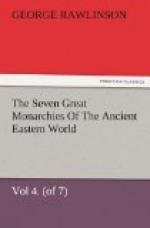Notions of legal cleanliness and uncleanliness, akin to those prevalent among the Jews, are found to some extent in the religious system of the Babylonians. The consummation of the marriage rite made both the man and the woman impure, as did every subsequent act of the same kind. The impurity was communicated to any vessel that either might touch. To remove it, the pair were required first to sit down before a censer of burning incense, and then to wash themselves thoroughly. Thus only could they re-enter into the state of legal cleanness. A similar impurity attached to those who came into contact with a human corpse. The Babylonians are remarkable for the extent to which they affected symbolism in religion. In the first place they attached to each god a special mystic number, which is used as his emblem and may even stand for his name in an inscription. To the gods of the First Triad-Ami, Bel, and Hea or Hoa—were assigned respectively the numbers 60, 50, and 40; to those of the Second Triad—the Moon, the Sun and the Atmosphere—were given the other integers, 30, 20, and 10 (or perhaps six). To Beltis was attached the number 15, to Nergal 12, to Bar or Nin (apparently) 40, as to Hoa; but this is perhaps doubtful. It is probable that every god, or at any rate all the principle deities, had in a similar way some numerical emblem. Many of these are, however, as yet undiscovered.
Further, each god seems to have had one or more emblematic signs by which he could be pictorially symbolized. The cylinders are full of such forms, which are often crowded into every vacant space where room could be found for them. A certain number can be assigned definitely to particular divinities. Thus a circle, plain or crossed, designates the Sun-god, San or Shamas; a six-rayed or eight-rayed star the Sun-goddess, Gula or Anunit; a double or triple thunderbolt the Atmospheric god, Vul; a serpent probably Hoa; a naked female form Nana or Ishtar; a fish Bar or Nin-ip. But besides these assignable symbols, there are a vast number with regard to which we are still wholly in the dark. Among these may
[Illustration: PAGE 229]




